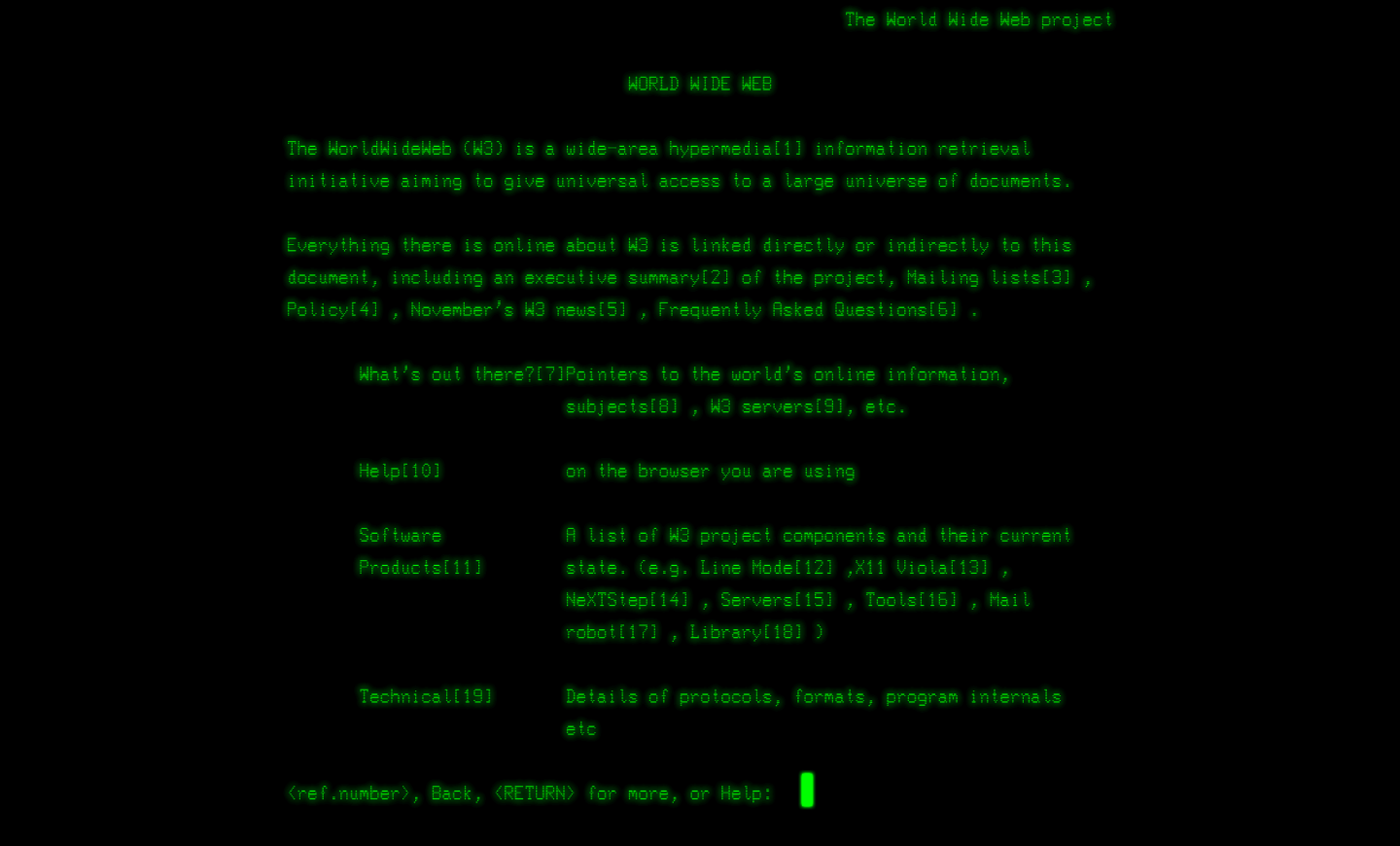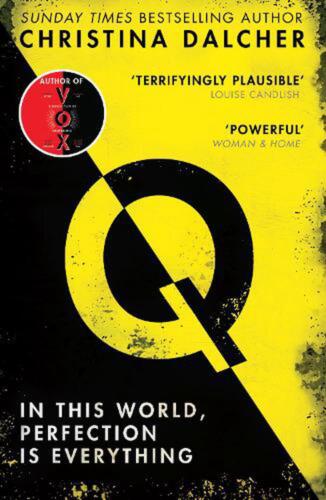King of slop: How anti-migrant AI content made one Sri Lankan influencer rich: He now teaches a course on how to leverage that anti immigrant sentiment in Britain to make huge profits.
Recently I read:
‘Too little, too late’: damning report condemns UK’s Covid response: The findings of part 2 of the Covid enquiry.
No pasarán: anti-fascist slogan takes on new significance in Ukraine crisis
The WorldWideWeb (W3) is a wide-area hypermedia information retrieval initiative aiming to give universal access to a large universe of documents.
As says the intro to the first ever webpage, still at its original URL.
Clearly as it has links to a few other sites - back in the days when a short contents page covered all your web-searching needs - it’s not the very first version of the first page. Here’s a recreation of more what it actually looked like, courtesy of CERN.

Here’s how they explained the intent of the system:
The project is based on the philosophy that much academic information should be freely available to anyone
Ah, the blissful innocence of yesteryear…
What causes the Overton Paradox?
Brilliant.org has a fun interactive explainer of the Overton Paradox, at least as enacted in the US.
The paradox is as follows: Why is it that on average people are more likely to say that they’re politically conservative when they get older, but yet when you ask them about their actual beliefs they appear to have become a little more liberal?
Along the way, we learn about the difference between age effects and cohort effects, which is important to understand in many domains of analysis.
Spoiler: the theory suggested is along the lines of:
- Firstly, people judge their left/right position relative to the perceived center of the population rather than by adherence to certain policy ideas.
- The center has being trending more liberal over time, faster than the average drift an individual person makes over their lifetime.
- Whilst both are likely real effects, the main driver of the centre shifting is the net replacement of older people of one generation, typically more conservative, with younger people from a newer one who are typically more liberal.
- Nonetheless, each group, whether self-proclaimed conservative or liberal becomes more liberal as time goes on: a liberal from the 1970s has similar beliefs to a conservative from 2022. They’ll just think they’re more conservative because the baseline has changed.
Anyway, if that was a bit too much wall-of-text, then checkout the much prettier and more engaging Brilliant.org interactive explainer.
🎮 Currently playing The Battle of Polytopia.

It’s a world-domination strategy game vaguely along the lines of the famous Civilisation game. But far simpler to understand and much quicker to play.
You pick a tribe and are inserted into an unexplored territory of mystery, whereupon you gain the all-important points by exploring, researching, building up your towns and army, as well as potentially battling any opponents you come across who are doing the same. These can be computer enemies or there’s also a human multi-player option.
It’s perfectly playable on, and I think perhaps initially developed for, your phone. You can download it from the app stores for free and optionally choose to pay to be allowed to play as different tribes. But it’s also there on Steam and some games consoles for the larger screen experience.
OK, it is Elon Musk’s favourite phone game, but don’t let that put you off.
The revelation that and his brother had conversations about the life lessons they learned from it is pretty cringe though. Just for the record:
- Empathy is not an asset
- Do not fear lose
- Optimise every turn
- Play life like a game
- Be proactive
- Double down
- Pick your battles
- Unplug at times.
Some of those might explain a lot. Don’t worry though if you’re a multiplayer fan. Apparently he had to stop playing at the point that he was so obsessed by it he started dreaming about it. By then it had started making him late for meetings and causing fights with his partner at the time, Grimes.
So far I don’t think it’s entirely drained me of empathy.
My Microsoft Surface laptop decided not to recognise that anything was plugged into its USB ports today. No idea why. But this meant I couldn’t charge it or use the vast array of bits and pieces I have plugged into its dock. No amount of cable swapping or rebooting helped.
What eventually solved it, thanks to a tip from a colleague, was to shut down the laptop and unplug the USB-C cable. Then to hold the power button for 20 seconds until the Windows logo appeared, went away, and appeared once more. Once the computer finished loading up the USB-C charger and everything else that was plugged into it worked just fine.
No idea why it worked, but it did.
🎙️ Listening to The Studies Show podcast.
A couple of science writers I’ve followed for a while, Tom Chivers and Stuart Ritchie, get together once a week to discuss some vaguely controversial scientific issue.
Are there studies supporting the clickbait headlines? What do the research papers cited by reporters and authors in support of a proposition actually say? Were they any good in the first place?
To give a flavour of what goes down, their first few episodes were about the GLP-1 anti-obesity drugs, breastfeeding, aspartame and psychedelics.
It’s not overly hard going. If you have a passing interest in reading newspaper science sections or popular science books then you’ll do fine here.
What I have to call out for special credit is that the shownotes from each episode give the actual references and links to the papers they discuss. Of course this shouldn’t be remarkable for a podcast that is entirely about scientific studies. But there seem to be many other ‘science’ shows out there that make it unnecessarily challenging to figure out exactly where they’re pulling their information from that, even now, it’s a real treat to see the sources shared up-front
Last week, while checking the device of an individual employed by a Washington DC-based civil society organization with international offices, Citizen Lab found an actively exploited zero-click vulnerability being used to deliver NSO Group’s Pegasus mercenary spyware.
Citizen Lab reports the discovery of the ominous sounding ‘Blastpass’. This is a bug in the operating system of most Apple devices that allows someone to infect your phone with spyware simply by messaging you a special image. The recipient doesn’t have to click on anything.
It reminds me of that time in 2019 where users of WhatsApp on both iOS and Android devices could be infected via receiving a WhatsApp call, even if they didn’t answer it.
Back then, a lawsuit alleged that at least 1400 people were subjected to it:
Over an 11-day span in late April and early May, the suit alleges, NSO targeted about 1,400 mobile phones that belonged to attorneys, journalists, human-rights activists, political dissidents, diplomats, and senior foreign government officials
Similarly to what the above implies, the feeling seems to be that probably for now if you’re not someone being personally targeted by an extremely resourceful adversary then you’re probably OK. But still, best to upgrade to iOS 16.6.1 or put your phone into lockdown mode.
Liz Truss is writing a new book 😟
After winning the record for being the only UK Prime Minister with a shorter lifespan than a lettuce - and perhaps one of the most incompetent ones although the last few years have made that quite a competition - Liz Truss is back on the scene with a new book soon to come out called…drum roll…"Ten Years to Save the West".
It sounds like it’s exactly what you would guess from a title so trite and overdramatic it’ll make your eyes roll right out of your face. Yes, despite the fact that the UK has had a ludicrously performing government of the right for the past 13 - unlucky for some - years, apparently it’s all those sneaky communists (?) that are ruining everything.
…the rise of authoritarianism around the world and the adoption of fashionable ideas propagated by the global left give us barely a decade to preserve the economic and cultural freedom and institutions that the West holds so dear.
Absolutely unsurprisingly it seems like it’ll contain a good amount of that favourite hobby of the modern-day Conservative cosplayer: heart-felt worship of Thatcher.
The Mail on Sunday shares an interview, which even they seem to feel is a bit of a wild one at times.
Sitting incongruously beneath a picture of the Marxist revolutionary Che Guevara bizarrely blended with Lord Nelson – a nod by Norfolk MP Ms Truss to the county’s most famous son – she launches a passionate defence of her own attempted revolution, which died when the markets crashed in the wake of her radical tax-cutting Budget.
Why was she such a failure? Not because, heaven forbid, she made any serious missteps in her short reign of power. It’s everyone else’s fault for not loving her ideas enough.
…the fundamental problem was there wasn’t enough support for Conservative ideas…
from, once again, a very much majority Conservative government she was part of.
Tin foil hat time:
…the ‘global Left’ were in control. ‘Ideas like redistributionism, business being bad, the anti-growth people like Extinction Rebellion and Just Stop Oil – those are the ideas that have made the running in the last decade,’ she says.
Yes, sure, everyone loves Extinction Rebellion and hates businesses too much. Those closet Commies are just….something something…such that it simply appears that people dislike ER and the British titans of business are getting unspeakably richer each day whilst everyone else sits in a cost of living crisis.
‘You’ve got the global Left which Biden is obviously a key part of, but also the global environmental movement, the Greta Thunbergs of this world, the anti-capitalist movement, and they have been very effective in pushing what is politically acceptable.’
I guess I missed the news that Greta is the current PM of the UK and that capitalism has been overthrown. Presumably the state now owns the means of production I’m typing this on. I mean, some would say that her desperate premiership did more than the rest of us combined to discredit free market economics and their animal spirits. They certainly didn’t like her; the crashing of the British economy being of course much of the reason she had to go.
She’s also actively campaigning for “a Republican” to win the next US election, which is perhaps a little surprising after the fuss her treasured Boris made about “allies and friends” getting involved in each other’s election campaigns.
Inevitably the typical new-levels-of-desperation-provoked Conservative fixation on US-style culture war issues raise their head. She’s apparently terrified that the West is about to be destroyed whilst “our culture is being questioned, even basic things like human biology”. We all know what that means.
Mainly that it’s probably only a matter of time before she starts a Substack and appears on multi-hour Qanon-adjacent podcasts to complain about terrible being cancelled was, albeit the kind of cancellation that involves “the left” mind-controlling you to choose to resign from literally running the country and write a book whilst earning £16,500 per hour for making speeches.
Over here I wrote about some research from Pew comparing what Twitter users say they do vs what they actually do.
As ever, turns out either:
- we don’t have very accurate insights into our own behaviour.
- we aren’t prepared to tell other people about it.
- some studies are subject to a lot of measurement error.
or, most likely, all of the above.
🎶 Listening to Hell Is A Teenage Girl by Nessa Barrett.

Nessa is a Tiktok star. Perhaps a true emissary of Gen Z with possibly the somewhat stereotypical Gen Z habits of spending time staying in writing in her gratitude journal and doing tarot alongside her cat whilst releasing TikTok videos rather than the again stereotypical debauched and drunken lifestyles of such stars in former generations
Some of her ability to attract an incredible number of fans likely comes from her openness about her mental health problems. Sadly it sounds like she’s suffered tremendously from a range of conditions.
She’s also musically talented enough that posting her vids on TikTok led to a recording contract with Warner Brothers.
I think I read somewhere that the concept behind much of this EP is to enumerate the stages one goes through after a rough relationship breakup - the incompatible thoughts one might have: reminiscing, happy memories, disgust, hatred, caring nothing, caring too much. Aspects of it remind me of several other artists, from Taylor Swift to Girl In Red; the last song giving me the vibes a somewhat less intense version of Serotonin.
This looks like a handy comparison guide to free and open source photo libraries for anyone contemplating extracting their digital memories from the clutches of the big bad adtech industry.
The corporate jargon being most forcibly injected into my ears in recent days:
- HMW: how might we
- KOL: key opinion leaders
- RTB: reasons to believe
MusicBrainz Picard fixes your musical MP3 tagging woes
MusicBrainz Picard is a great utility to clean up your computerised music collection if like me you are old and lazy enough to have the occasional folder of MP3s (or other audio formats) ripped from CDs years ago which you cunningly named “track1.mp3”, “track2.mp3” whilst not bothering to add any title or artist metadata. Or if you’re the type to get deep into tagging precisely which edition of which thing published where your music is.
You just tell the software where your tracks are and it tries to recognise them in a couple of ways. It can go by their AcoustID fingerprint if there is no metadata - meaning it can work even if you haven’t got a clue what or where your file came from.
If it can’t figure it out automatically then if you do know what album or song it probably should be it allows you to manually search the database for it in your browser. No matter how you proceed, it’ll later provide an indication of how confident it is in the matches based on things like track length.
Once that’s all down, hit save, and your files will be rewritten with the appropriate metadata taken from the incredible MusicBrainz database, and renamed nicely if you select the appropriate option.
If your files are obscure enough to not be in the MusicBrainz database then I guess you’ll have no luck. But I haven’t encountered this yet.
The only minor problem I’ve had is when it identified my music as being a release of the correct album but in another country. No big deal if you’re not a perfectionist - but if you want the exact right cover and publication metadata then that was easily fixed by using the manual search feature which lets you pick specific country releases.
More data leaks
Another day, another mass data-leak. The one that caught my attention most recently was that the details of 2.6 million Duolingo users were for sale on hacking forums. To be fair, it looks to be less “hacked” and more a product of misusing the DuoLingo API in order to collect data that could include people’s real name, email address and some DuoLingo specifics such as what language the user was learning, as well as some profile settings.
Much of this except email address was technically “public” in that you could see it on a user’s profile or at least access it via the API. But by feeding the API a big list of email addresses, probably obtained from some other leak, one could confirm their association with a DuoLingo account. This join to email gives an obvious opening for scammers to send accurately personalised spams or phishes - “Hey, to continue your French lessons we need you to re-enter your credit card details here” type stuff.
As it happens I wrote about one way to programmatically access your data from DuoLingo the past. But there I promise that I was more interested in the data of my on progress rather getting everyone’s data to sell.
It’s only because I’ve used DuoLingo that this stood out to me I guess. It’s far from the worst leak in recent times. Just this month we’ve seen details of 40 million UK folk leak from the UK Electoral Commission, details of 760000 Discord.io users released (enough to shut the site down for now) and 10 million French residents exposed via a leak from their government’s unemployment registration agency.
Basically, it’s feeling ever more like if anything related to you is on any computer connected to the internet anywhere in some form other than heavily encrypted then you might consider it could potentially become public one day. In some cases even if you explicitly deleted it years ago.
Q by Christine Dalcher reminds us of the dangers of taking meritocracy too far
📚 Finished reading Q by Christina Dalcher.
Set in in a United States of the (near?) future, this book imagines a society where your status, what you’re allowed to do, what access you have to things, even where you must be is governed by your “Q” score. Q is a kind of measure of intelligence, ability and moral worth. It can be thought of as an enhanced social credit score, a quantified meritocracy.
Life can be very good for those with high Q. At least materially; the threat of losing one’s position is of course ever-present. But the experience is grim for those who have been tarred with the brush of having a naturally low Q.
The book tells of the experience of Elena, a mother who has two children with very different Qs.
The story goes that she herself was very influential in the development of the Q system. The slightly incredible suggestion is that it originated from a system she and others got instigated at their school when they were students to help them cope with the relentless bullying in the before-times. Today though any concerns of bullying are gone; she’s a respected lecturer, high Q. Her husband is a high-up government official largely in charge of managing the Q system. They lead an easy life of relative luxury. In some ways, the Q system is their doing and they certainly benefit from it.
Until they don’t, or at least Elena doesn’t. Her callous husband cares little for their child with insufficient Q. The powerful in society certainly don’t care at all. But, hey, it’s OK. Every child has a place. Trying not to spoil anything, it’s just not a place Elena wants her child to go. And her new need to dig into the workings of the system lead her to discover the twisted goal it’s taken on and the horrific methods that it uses to that end.
It’s not a subtle book. There are plenty of vibes of things that exist today. The Chinese social credit system comes to mind, as does the “Nosedive” Black Mirror episode. More generally ,the pernicious inequalities foist upon us all depending on what the society you happen to be in today values and permits - witness the semi-panic in the recent AI hype cycle where folk with reasonably high-status jobs worry that they’ll be replaced with a computer - and the politics that follows..
The stratification of modern-day schooling and with a potential over-emphasis on tests is already a part of today’s world in many places. As is a veneration of a meritocracy that doesn’t really think through its more problematic consequences. Genetic engineering and its consequent potential for selecting the attributes of future babies are work in progress. And we should never forget the still frequently overlooked history of the role that eugenicists have played in the United States - “Three generations of imbeciles are enough” - and elsewhere, including of course the most infamous instantiation of all.

TIL: There’s a version of chess you play on a hexagon shaped board made up of hexagons.

It takes 3 colours of hexagons to make sure no hex is next to another of the same colour. And the way bishops move is particularly mind-twisting. What does diagonal even mean in a hex world? This vid explains it well:
Play it online on various websites including this one.
Experiencing the Dream Machine
Last week I got to go experience the Dream Machine with a friend. The nature of the experience is such that I think it'’ll be extraordinarily hard to convey via text, but I’ll give it at least a weak go.
The overall conceit of the project is that when placed in a dark room, a mix of flashing lights and sounds can alter your conscious experience. Or rather it “invites you on a magical journey to explore the extraordinary potential of your mind” to quote their website.
First up you start off in a room where past participants have attempted to draw what they experienced. You get to do the same when you’re done, although my art skills are such that I didn’t even try. Many of these pictures resemble colourful geometric patterns or bright fields of light. A handful appear to contain human-looking objects, perhaps aliens, that kind of thing, especially exciting to me. You can see some of these pictures on their their website. Here’s an example:

Next up they relieve you of your phone and other devices and, unexpectedly, your shoes. You’re issued a bag that contains some hotel-style slippers, an eye mask and a blanket. There’s a short safety talk to check everyone’s willing and ready. The default experience is not suitable for people with sensitivity to flashing lights (precluding folk with some forms of epilepsy) or loud sounds. But they do have modified experiences available that should allow most people with those sensitivities to proceed if you let them know that’s what you’re after.
You’re led into a kind of inside tent with maybe 10-12 people to sit space d out on a large circular sofa type thing. The back of it is slanted such that you’re half lying down. Two speakers surround your head. There’s a big white spherical thing on the ceiling, which is the soon-to-be-flashing light. Your bag’s blanket is for if you’re a bit cold. The eye-mask is for you to put on if the experience starts to feel temporarily too much.
More safety briefing and confirmations that one is ready to proceed are given. Whilst the supervisors aren’t going to be in the room with you when the experience starts they must be watching you I suppose as the deal is that if you need help you should wave and they’ll come help you. All this is either a bit off-putting or a bit exciting depending your constitution, I definitely felt the latter.
Two key facts include that 1) you should keep your eyes shut throughout the experience if you can and 2) no matter what you think is going on out there they promise that all they’re actually doing is flashing a white light at various intervals. Anything else you perceive is coming entirely from the mysterious world of your brain.
Then there’s a little taster session just to make sure everyone is OK with the actual experience rather than a description of it. The room goes dark, you close your eyes and a prerecorded audio grounding starts. If you’ve done certain types of meditation (including the app types) it’s that kind of thing. Focus on your breath, your body, and so on. Then the sounds start, slightly ethereal music for the most part. And through your closed eyes you can tell the light must be turning on as a kind of brightness changes your eye-closed perception, similarly to how you know whether it’s a sunny day or the middle of the night when you wake up each day but can’t be bothered to open your eyes.
Then a few minutes of presumably flickering lights, sometimes fast, sometimes slow, wherein you get a taste of what’s to come. The taster experience soon ends. The supervisors return and check that everyone is fine to proceed. Everyone was, so the main experience begins, again with the grounding.
This main course is a lot longer. I’m not actually sure how long. Maybe 20 minutes? It’s not like us humans are particularly good at keeping track of time in our heads even when at our most connected to stark reality, which in this experience is not really the case.
The sounds start, the light flashes, on and off, fast and slow, and your mind does what it does. Which in my case was mostly giving me visions of animated geometric patterns. Sometimes white, in line with the white light that we’re told is the entirety of the external generative process. Sometimes not. Deep reds, yellows and oranges filled my inner eye at times.
These were usually organised into field-of-perceived-vision-encompassing dots, hexagons, and a repeating motif of diamonds. They zoomed in and out, they swirled, transitioning more intensely from one to another than even the best PowerPoint could. They exploded. They shrunk into nothingness. At first I felt just a little stressed or even nauseous perhaps, but it didn’t last long and I relaxed into it to enjoy the perception show.
At one point I kind of felt like I saw a face in the centre of my vision - an alien? A God? Who knows? - but as much as I tried to focus and keep the glowing white visage present within the vision, the surrounding burning-white pulsating diamonds suddenly expanded and occluded the face within seconds.
So all in all, a lot was going on. Time flew, and I was not really ready to stop when unfortunately it was time for the experience to end. At that point you leave into a far more normal room with the possibility to draw something of your experience, write about it or just chat around a literal watercooler.
It was my friend’s second time at this kind of show, so one of my immediate questions could be answered. Apparently no, you do not see the same thing each time you do it. And also, as intuitively would be the case, not everyone sees the same things. You are to be silent during the experience so there’s no real way of communicating live what’s going on in your head, and maybe it’d ruin the experience if you tried to do so. But for sure we saw different things; deep blues for her if I remember correctly, reds for me. Assuming we mean the same things with the same words, that classical challenging philosophical problem. I expect humanity’s inner mental lives are as diverse as their outer characteristics.
Tickets are currently £15 and you’d need to get yourself to Hackney, London - everything you need to sign up is here.
Fun fact: apparently this was originally designed as part of the Festival of Brexit (aka “Unboxed” but the former name is much funnier). It’s not an original observation, but there are certainly plenty of folk out there who think that anything designed to alter your consciousness in any direction away from the grim reality of contemporary Britain is the best that we can really hope for to be fair. The Government’s DCMS committee said the whole thing was an “irresponsible use of public money”. The festival of course, not Brexit, definitely not.
It’s much earlier inspiration comes from work by an artist called Brion Gysin. In 1959 he made a much smaller device that used flickering light to create “vivid illusions” in the minds of those who experienced it.
Here’s a photo of it taken by Charles Gatewood.

Gysin designed it after noticing that the flickering of sunlight when driving through trees put him into a somewhat hallucinatory state.
The Dreamachine would awaken humanity, Gysin hoped, from cultural stupefaction and liberate us from being passive consumers of mass-produced imagery. Gysin hoped it would replace every TV in every home in the US and make us creators of our own cinematic experiences.
It might surprise you to learn that that’s not quite what ended up happening. But I’m glad its derivatives are still around for us to experience all these years later.
The trials and tribulations of installing Linux Mint alongside Windows 10
Over the past couple of days I’ve managed to install Linux Mint onto my Windows 10 computer. The last straw for Windows was when it advertised some story about how great Wetherspoons is to me when all I wanted to do was open some software. My computer also is prohibited by Microsoft from upgrading to Windows 11 (it is old…but runs Windows 10 just fine) so at some point in the possibly distant future I imagine that could have caused me a problem. I’d also like to move more and more towards open source software, at least for my personal computing.
Below is what I did. It didn’t go as smoothly as I’d hoped to be honest. I probably made it more difficult than I needed to for myself to be fair, and Windows played tricks on me too. But in the end it seems to be working well I’m writing it here in case I need to do it again or someone else encounters the same obstacles.
So there are various ways you can install Linux Mint on a computer that currently has Windows on it. That includes starting afresh, deleting everything you already have, Windows and all, and going 100% Linux. You can also use Linux Mint inside Windows using a virtual machine without having to do anything to Windows - it acts just like another piece of software you install in Windows, but has the obvious memory and processing overhead of having to run Windows and Linux simultaneously. You can also use it entirely from a USB drive. But I chose to go with probably the trickiest of options dual-booting.
The idea here is that in the end what should happen is that each time my computer turns on it gives me a menu letting me choose whether I want to use Windows or Linux. I thus can choose between Windows and Linux each run and they’ll act independently of each other. The natural cost is that you need to dedicate a certain amount of disk space to both operating systems and any files you want to use in them - but it’s better than having to buy a whole new computer. It’s also proved more tricky to set up than I imagine the other options would have been, although I do lay some of the blame at Windows' feet whilst sucking up a decent chunk of it as being down to my own ignorance.
Get and validate the Linux Mint install software
Step 1 was to download the ISO file containing the Linux Mint image I wanted to install. I went with the “Cinnamon 64bit” version. Also get the sha256sum.txt and sha256sum.txt.gpg files from relevant Linux Mint download page (this was the edition I used) which lets us verify the integrity of the ISO file later.
Once downloaded, verify the file by comparing hashes. I only had access to Windows so per these instructions I downloaded GnuPG - the “Simple installer for the current Gnu PG” from here.
Then to check the integrity if the ISO:
Open a command prompt (PowerShell) in the folder I downloaded those to and ran
CertUtil -hashfile linuxmint-21.2-cinnamon-64bit.iso SHA256
Check that the results matched the sha256sum.txt file.
To check authenticity:
Run gpg --keyserver hkps://keyserver.ubuntu.com:443 --recv-key 27DEB15644C6B3CF3BD7D291300F846BA25BAE09
Then:
gpg --verify sha256sum.txt.gpg sha256sum.txt
And check that the output says “Good signature from “Linux Mint ISO Signing Key root@linuxmint.com” and the primary key fingerprint at the bottom matches the 27DE…. code from the first gpg output. Don’t worry about the warning about the key not being certified.
Make a bootable Linux USB stick
Now we need to to make a bootable USB stick from the ISO image. First find a USB disk you don’t mind emptying out as this will remove any existing files on it. After that, here are the instructions. For Windows they suggest you install Etcher. I downloaded Etcher for Windows Portable Edition but presumably any should work.
In Etcher, choose to “Flash from file” and select the ISO image you downloaded in the first step. Then “Select Target” to choose your USB drive (after plugging it in, and remembering that you’ll lose any data on it). Then select to flash the drive and wait a few minutes until it’s finished.
Prepare disk space for Linux to install to
Next up we’ll need to create a partition for Linux Mint to install to. Probably your disk is already partitioned 100% for Windows. I needed to reduce the size of the Windows partition and create a new one with space from Linux.
Although the instructions for Linux Mint read to me like you can do this during the Linux Mint install process, most of the info I read on the internet suggested to do it first in Windows, with the Windows specific tool, given you’re messing around with a Windows partition. This is “fiddling around with hard disks” type stuff, so everyone recommends that you back up anything important before doing it just in case either you or Windows does it wrong and lose it all.
Then I did the below:
- Open the built-in app “Disk Management” in Windows - one way to get to this is open the Start Menu and start typing “Disk Management” until the option to “Create and format hard disk partitions” comes up.
- Right click the disk you want to “shrink” in order to make a Linux partition. For me this was the one labelled “C:”.
- Choose “Shrink volume”
- It asks you to input the “amount of space to shrink” in MB. I decided to give Linux 100GB to use for now so typed in 100000 and clicked “Shrink”.
- A while later the Disk Management screen updated to show a 97.66GB unallocated space. Seems like I should have remembered that 100000 MB doesn’t necessarily equal 100 GB if I wanted rounder numbers. But this will do for now.
- Note that of course whatever you “unallocate” here won’t be accessible to Windows. So you need to have a decent amount of free disk space to go this dual boot way.
Reboot from your USB drive
Now it’s time to boot up the bootable USB we created and install Linux into this free space.
First I checked the BIOS to make sure my computer could boot from a USB. For my old Sony laptop this meant turning it off and then holding down the special button marked “ASSIST” and choosing “Start from media”. For most less weirdly proprietary computers I think that’s usually case of looking at your BIOS settings to make sure your computer is set to boot from USB drive before your hard disk and then rebooting it.
Start it up again with the USB drive you prepared earlier plugged in. If you set the boot options correctly you will get a menu. I chose ‘Start Linux Mint 21.2 Cinnamon 64-bit’’'.
Start the Linux Mint installation wizard
After a few minutes and some slightly scary looking error messages I ignored it loaded up to a Linux Mint desktop. I double clicked the Install Linux Mint icon.
In the subsequent wizards, select your language, keyboard. I chose the option to ‘Install multimedia codecs’ which meant I had to configure secure boot by choosing a password as I apparently have UEFI secure boot enabled.
I think this stage later gave me problems. I’m not 100% sure this is why but I read somewhere that your keyboard will effectively be in US mode at the time of needing this password. So if you have a non-US keyboard then you might want to make the password pretty simple and not full of special characters. Letters and numbers worked for me. Note that you only need to use this password once.
Next up in the install wizard, I chose “Install Linux mint alongside windows boot manager”. A message popped up explaining what changes it was going to make. It wasn’t all that helpful. But I think it did everything OK. There is a “Something else” option if you prefer to try and manually figure out / exert some control your partitions. Most internet guides seem to recommend that, but I must admit I did the “install alongside” option.
Next up I chose my time zone, and chose a username, password, computer name and chose to encrypt my home folder. This password is the one you’ll use to log onto Linux Mint every time so make sure you can remember it. The system then started to install.
I then let it restart the computer, removing the USB when it told me too.
Manage your MOKs (?)
A blue “MOK management” screen appeared. I had no idea what this meant. I think what I should have done was to choose the “Enroll MOK” which was the second option I was presented with, view the key and choose to “Enroll key”. The password is the first password we recorded above, the one to do with the multimedia codecs.
However I had little idea what any of this meant so by the time I got to it it had timed out and automatically picked the first option which was to continue the normal boot process. This loaded up Linux Mint but I’m led to believe this meant the multimedia codecs and maybe some other stuff wouldn’t work. You really want to enroll the MOK.
But it’s a one time prompt - reboot and you’ll not get a chance to enroll the MOK key again. Oh no! But there is a way to reset this and get the MOK key prompt to come back.
Getting the MOK enrollment screen to come back if like me you did it wrong the first time
Thank you to Philip from the 11th post here who documented that if you load up to Linux and type this into the command prompt:
sudo mokutil --import /var/lib/shim-signed/mok/MOK.der
Then the next time you restart you’ll get that option to Enroll MOK again. Running the above will ask perhaps for your “root” password which is the second one you selected above and then for you to define a new password. That’s the equivalent of the one-use first password we encountered above with the multimedia codecs. So probably make it fairly simple. It won’t affect the password you log onto your computer with. But it’s this one-use password you use to enroll your MOK.
If feeling particularly committed, this page describes a bit more about what these keys and commands are for. If your computer isn’t “blessed” with SecureBoot then you may not see any of this.
After that, all seemed well. Whenever I turned my computer on I could choose between Linux and Windows just like I wanted.
Connecting to the internet
At first the wifi didn’t work, but once I went into the built-in Driver Manager in Linux Mint and inserted my install USB key when prompted. It scanned, found my wireless card, and when I selected the only option it gave me other than “don’t use it” that all started working well.
When Windows forcibly takes over again
I was glowing with success only for a few minutes until Windows turned nasty….The first time I chose to load Windows it appeared to overwrite the startup menu where you choose between Linux and Windows. Apparently this is pretty normal. I guess Windows just can’t believe that you don’t want to 100% use it and its extremely undesirable Start Menu.
So whilst I’d successfully installed Linux Mint, after the first time I’d loaded up Windows I wasn’t given the option to actually use Linux ever again. Aaargh.
The internet has a vast array of frustrated users and posts with helpful suggestions about what lengthy thing you should type in to where to hopefully sort this problem out. But not a single one of the ones I saw quite worked for me. However they did provide enough clues that I think I eventually got to the bottom of it.
I can’t say I fully understand everything I did here, and it’s probably not very risk free for anyone with no backup, but here’s what worked for me in case I ever need it again. Honestly though, unless you understand it better than me I wouldn’t run it without having a great backup, a bit more research or an expert friend.
First up, you’ll need to get back into Linux however you can (remember you can most likely boot from your install USB if you’ve no other way). Then open the command prompt (aka terminal) and run:
efibootmgr -v
I got a list showing the partitions that could boot and thee order that they’d apparently do so in. One row for Windows and a couple for “Ubuntu”. One of these rows was my main Linux Mint install. The other is “grub” which is the menu system that lets you choose which OS to start when you turn your computer. Windows kept insisting on enabling itself and acting like it was first on the list no matter what I did whereas I needed the grub one to take precedence. The intuitive thing of “change the boot order to the order you want it to be in” did not help.
So I noted down the filenames each of these entries were associated withl- the parts starting:
/File(\EFI\....
The Windows one in my case was the file:
\EFI\Microsoft\Boot\bootmgfw.efi
The “grub” one was:
\EFI\ubuntu\grubx64.efi
The Linux Mint one was:
\EFI\ubuntu\shimx64.efi
Then, shutdown Linux, turn your computer off.
Reboot this time loading Windows (which is probably what will happen anyway given the issue we’re trying to solve here).
Open the Windows command prompt in administrator mode (which means to hold Shift and right click it and choose “Run as administrator” rather than simply double-clicking it) and type this mystical incantation into it:
bcdedit /set {bootmgr} path \EFI\ubuntu\grubx64.efi
Presumably if you saw something other than \EFI\ubuntu\grubx64.efi when you ran efibootmgr in the previous step then you should put what you saw relating to grub at the end of the bcdedit command rather than copying me exactly.
That said it completed successfully. And since then every time I restarted my computer it’s offered me the choice of which operating system to run exactly as it did before Windows greedily overwrote whatever I’d done in the first place.
If you decide you did want Windows to just load every time without prompting you could undo the above command by just specifying the Windows bootloader instead of the grub one I think:
bcdedit /set {bootmgr} path \EFI\ubuntu\bootmgfw.efi in my case.
Treating obesity can save lives
An important point for any debate about treatments for obesity that’s often missed or downplayed in certain media takes is that obesity appears to be causally associated with a range of other extremely serious health issues, including an early death.
As one example, in a recent review, Pati et al found that 4-8% of all cancers could be attributed to obesity, even if we don’t precisely know why that is yet. Having obesity also makes for worse outcomes in general if you do get cancer.
That study ended with a call to collect more data on cancer outcomes regarding the less traditional forms of obesity treatments; surgical interventions and pharmacological. As it happens, earlier this year a new study on the former was published. Adams et al find that bariatric surgery patients ended up having a 25% lower risk of developing cancer later on than their peers, along with a 43% lower risk to die from cancer.
A new RCT study that looks at the outcomes of one of the GLP-1 anti-obesity drugs that have taken some quarters of the world by storm, Semaglutide, is going to be presented soon. In the mean time, a press release has revealed some of the top-level effects. People with overweight or obesity who were treated with Semaglutide had a 20% reduction in major adverse cardiovascular events, including heart attacks, stroke and cardiovascular-related deaths.
We’ll not know the full details until the full study is published but, assuming the full study is deemed legitimate and in general reflects the headline, it’s hard to argue with the CEO of the Obesity Action Coalition who is quoted by the ConscienHealth blog:
Semaglutide for obesity is a life-saving medicine for a serious chronic disease. It is now crystal clear that making excuses to deny people the care they need for obesity is unethical.
Treatments for obesity are not about personal vanity, body shaming or anything along those lines. Sure, they can be misrepresented or misused, but so can a wide range of other less “controversial” medical treatments. But at the end of they day they are potentially life saving interventions and should be treated as such.
When some of your personalities go blind
Following on having been inappropriately surprised that a person with dissociative identity disorder (DID) might be allergic to orange juice whilst under control of some personalities but not others, I’ve now learned that it’s possible for some personalities to be blind when others are not.
Here we have a report of a patient known as B.T. She seemed to have been blinded as the result of an accident, and got the appropriate medical tests and later diagnosis for cortical blindness as a result of damage to her brain.
She also had DID. Imagine everyone’s surprise a few years later, being of the chronological age of 37 years old, when at the times when the personality of a teenage boy was in control she could see well enough to read.
It’s not that B.T. had just reported not being able to see for years. Brain tests showed that when in other personalities the areas of her brain associated with visual stimuli didn’t react to input at all, as one would only expect in anyone unable to see . But when in the personality that was able to see, the sight processing areas of the brain started to light up again.
Over time, with training, most of her other personalities learned to see again, although two remain blinded.
Russia's moon-landing attempt fails, but there's plenty more coming up soon
I’d totally missed that there’s a substantial amount of landing-on-the-moon activity going on at present. Most recently Russia’s attempt to be the first to land a craft, “Luna-25”, on the southern polar region of the moon - despite everything else that one imagines the administration of that country would be focussing on right now.
That region of the moon is unexplored by landers. It’s thought that there might be interesting ice deposits to examine there. It’s the only area of the moon that has craters with interiors that aren’t near-constantly in sunlight.
We do know what the moon’s south pole looks like from above though thanks to several successful orbital missions. Here’s an image from Wikipedia:

However the Luna-25 landing didn’t go well. As of yesterday it has officially “ceased to exist” as a result of crashing into the moon.
Here’s an artist’s impression of what it would have looked like if it had touched down in 1 piece, taken from the CBS article above.

Unfortunately, given the impact of the craft crashing into the moon’s surface, an artist’s impression is all we can expect from that mission.
India is attempting something similar with its Chandrayaan-3 spacecraft, due to land on the moon this week. In the US, NASA is funding a commercial attempt to land on the moon from Intuitive Machines later this year. Another commercial offering, this time from Astrobotic, is expected this or next year. China and Japan are also involved in moon-landing missions expected to take place over the next few years.
Most of these are put-robots-on-moon missions. However NASA’s Artemis program has a moon landing planned for 2025 - Artemis 3 - that is looking to drop a couple of human astronauts near the lunar south pole.
Twitter's habit of deleting or undeleting your posts at will
In the latest reminder that things you upload to the various big social media services aren’t yours and can’t be relied on to stay there forever, it seems like Twitter has removed all the photos and some of the links that folk posted on it between 2011-2014.
No-one seems to know if it’s deliberate or not,. The email address the press might contact to find out is still responding with the poo emoji.
The forthcoming change to prevent you from blocking users is however all-too-deliberate, which is an absolutely wild thing to do imo given some of the content I understand remains on there.
Somehow deleting 4 years of potentially treasured photos still seems on average less bad to me than a previous Twitter shenanigan that resulted in posts that you would justifiably assumed were deleted- because you personally deleted them a long time ago so why would they even still exist anywhere? - magically re-appeared once more. That one was probably down to incompetence rather than malice. But whatever cause it’s not hard to imagine all sorts of potential bad consequences, embarrassing, awkward or devastating arising, from that.
Whilst Twitter is the current exemplar of these kind of bad practices, seemingly largely because of who runs now runs it, there’s little reason to believe that the potential risks are all that much reduced with its competitors either. The sad fact that if you don’t own the means of computation then you can’t rely on it - admittedly to vastly varying extents - is highlighted here once again.
At the very least, it’s a reminder to re-learn the old lessons of backing up everything we care about and being super careful to never share anything there’s a chance we might not want to be publicly available in the future. In the real world, both are of course easier said than done.
Getting real SimCity vibes from the view today.

We’re up to 91 felonies now in terms of how many criminal charges have been brought against Trump. There’s also multiple civil cases, including the sexual misconduct one that he’s already lost
The latest batch are around his ludicrous pretense of having won the 2020 election in the state of Georgia. Corruption, abuse of position, lying, fraud, all that kind of very not-making-America-great-again stuff.
When only one of your personalities has allergies

📧 Reading John Medina’s Substack newsletter. He’s a developmental molecular biologist, and author of Brain Rules. Each newsletter I’ve seen so far usually provides a quick summary of something unusual, occasionally jaw-dropping, about the human brain, how it works, what it does.
Issue 25 was one that stood out to me. It told the story of “Timmy”, one of the “personalities” that a patient with Dissociative Identity Disorder (aka DID, previously referred to as Multiple Personality Disorder) had.
Over time his body would appear to be inhabited by one of around 12 different personalities, if that’s the right word. Some of his personalities were allergic to orange juice. If he drank whilst one of these was active then his skin swelled up, became red and developed hives. This is not so unusual, people often have allergic reactions.
The twist is that some of his other personalities did not have this allergy. If they were in charge of his inner show at the time of drinking a glass of juice then his body wouldn’t show any of those symptoms. No sign of any allergy was to be found.
If he switched from a personality that was allergic to the juice to one that wasn’t in the middle of undergoing an allergic reaction then his hives, redness and itching would simply disappear.
It thus became apparent that what’s usually assumed to be a physical, deterministic, response to a chemical is in fact context dependent. Whilst no-one thinks we usually consciously “create” our allergic reactions, this suggests that something somewhere in our brain must unconsciously be governing them. Hence there’s a sense in which they are under our control, existing in relation to us rather than simply being an inanimate “fact of the universe” - even if we don’t know to how to consciously leverage them
“All in the mind” is a phrase that often used derogatorily, unsympathetically and dismissively to patients suffering various conditions, as if suffering situated primarily in the workings of the mind was somehow of lesser concern than suffering entirely on overtly physical phenomena. But stories like this constantly keep me wondering to what extent almost anything of note is at least somewhat “in the mind”. The book “The Expectation Effect” added a ton of counterintuitive examples towards that end.
Maus: The Pulitzer-prize winning graphic novel that portrays the horrors of the Second World War
📚 Finished reading: The Complete Maus by Art Spiegelman.

This is a comic book portraying the author’s difficult conversations with his father about the father’s experience as a Polish Jew in the Second World War. Harrowingly, but far from uncommonly, the experience included time imprisoned at concentration camps, including the infamous Auschwitz.
Most of the people he knew, most of the characters in the book, ended up dying at the hands of the Nazis. They are shot, hung or, more frequently, the victims of a long, slow, tortuous death journey of absolute neglect from captors who do not see you as human.
Actually the book doesn’t portray almost anyone as human, not in literal terms. Whilst the concepts of humanity and inhumanity infuse the story throughout, visually the participants are portrayed as cartoon animals. The Jews are anthropomorphic cartoon mice. Their former gentile country people, occasionally later collaborators, as pigs and the Nazis are cats. And the language is at times rough, ungrammatical, unrefined.
Out of context this might seem to be a strange or trivialising approach to the most awful of events. But in reality the stark black and white illustrative loses none of, and perhaps draws us into, the horror of what transpired. It pulls no punches. The frank representations of what went on maintain their visceral impact.
As Spiegelman once wrote:
Maybe vulgar, semiliterate, unsubtle comic books are an appropriate form for speaking of the unspeakable
This exchange sums it up the criticisms along those lines succinctly:
“Don’t you think that a comic book about Auschwitz is in bad taste?” one angry reporter asked him when the book was published in Germany.
“No,” Spiegelman replied, “I thought Auschwitz was in bad taste.”
The father, the “hero” who survived the horrors, is a complicated character. He’s on at least his second marriage and it’s not going well. He’s miserly, grumpy, demanding, with unpleasant views, whether shaped by his experience of things no human should every experience or otherwise. He’s demanding, an incessant. His son, the author finds him hard to be around, wants to avoid him, to get away even as he becomes increasingly unwell. The book switches between the father’s story of life in the war back to the present day life and its many tensions until both are resolved, one way or another.
The book - the only graphic novel to ever win a Pulitzer Prize at the time of writing - became more famous in recent times following a ban on it by a Tennessee school board, ostensibly for its bad language and a tangential depiction of nudity. In it’s time the book has also been banned in Russia and burned in Poland.
Many people believe that the in reality the Tennessee action was nothing more than a continuation of the politically driven book-banning so favoured by the supposed freedom-loving political right of the US. At the very least, I worry about the mind and priorities of anyone who thinks the most disturbing thing about this book is the occasional mild swear words.
But it’s the sort of disturbing that is important that humanity never forgets, never thinks can only happen once, only in the past. ‘Never again, and again and again’ to quote the author.